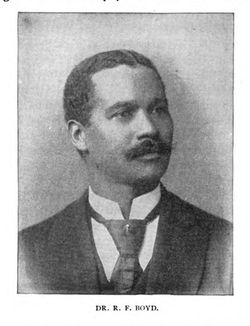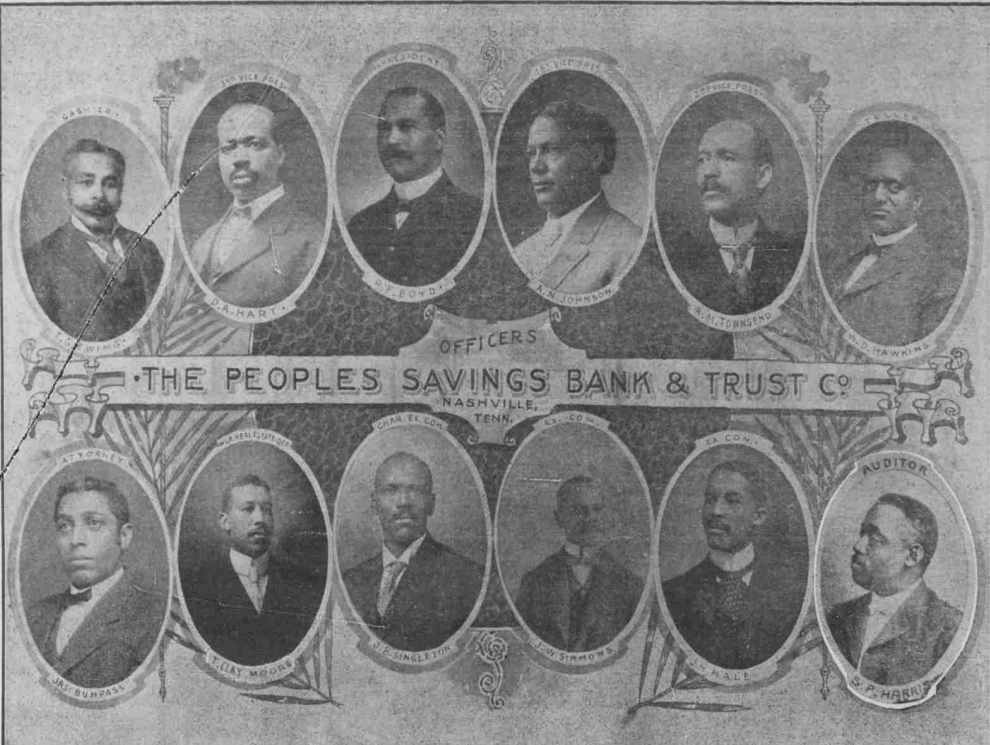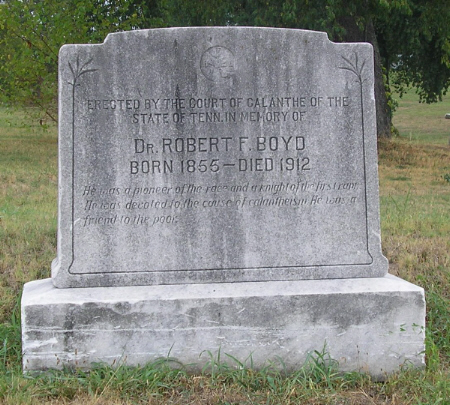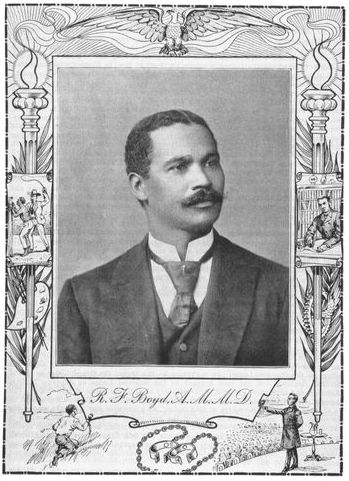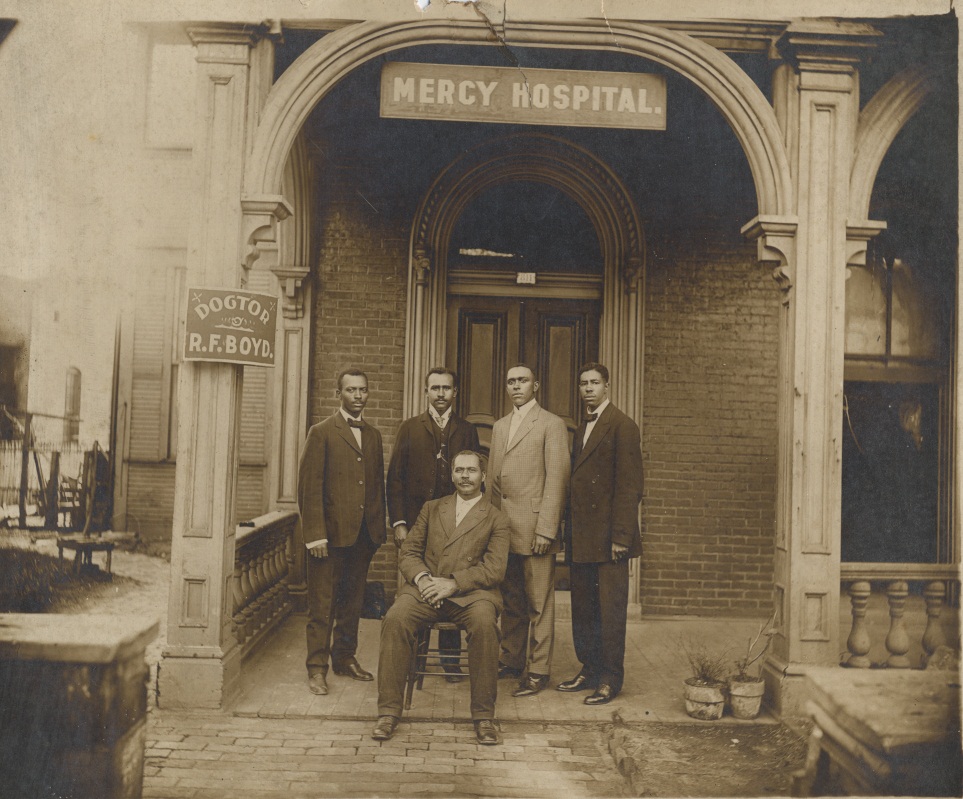He left in 1875 and began his teaching career at College Grove in Williamson County, Tennessee; Boyd returned to Giles County the following year. He soon became principal of the male school and the female department of Pulaski's public schools. Boyd entered the medical department of Central Tennessee College in 1880 and graduated with honors in 1882. After this, he practiced medicine and taught school in New Albany, Mississippi. He later returned to Meharry as adjunct professor of chemistry. While teaching, he entered the new dental department at Central Tennessee College graduating with honors in 1886.
One year later Boyd opened an office on North Cherry Street in Nashville to practice his professions among the less fortunate. By the turn of the century, he was treating patients in all social and economic classes. Doctor Boyd was particularly shocked by the black mortality rate, and in his paper entitled, "What are the Causes of the Great Mortality Among Negroes in the Cities of the South, and How is That Mortality to be Lessened?", he made some of the earliest and most astute observations regarding the physical conditions of Black Americans. Doctor Boyd used public forums, including Nashville churches, to help the Black public in the causes, origins, and transmission of tuberculosis, teaching them ways to combat this disease. During 1890, Boyd attended the Postgraduate School of Medicine at the University of Chicago. In 1891 he received the Master of Arts degree from Central Tennessee College. Two years later, Boyd ran for mayor and for a seat in the Tennessee General Assembly as a Republican. He returned to the Chicago school in 1892, specializing in the diseases of women and children.
His experiences in a Chicago teaching hospital proved highly beneficial to Meharry, as Boyd became professor of gynecology and clinical medicine there in 1893. Central Tennessee College had not secured funds for a teaching hospital, but when the city opened a hospital close to the school, students gained privileges there. Blacks constituted almost half of the patient population. For a time, the wards and clinics were opened to Meharry students, and then the city unexpectedly suspended the permission. This lost opportunity fired up the resourcefulness of Dr. Boyd, who opened Mercy Hospital in 1900, located at 811 South Cherry Street. Ten Black physicians with Dr. Boyd organized a national fraternity of black doctors of which Boyd was elected president. This group was the Society of Colored Physicians and Surgeons, which later became the National Medical Association.
In the 1890s, he purchased a three-story brick house on Cedar Street for $14,000, (at the time) reportedly the largest transfer of real estate to a person of African descent in Tennessee. When Nashville's second Afro-American bank, People's Savings Bank and Trust Company, was organized in 1909, Boyd was elected its president. Death came suddenly to Dr. Robert Fulton Boyd on July 20, 1912, following an "attack of acute indigestion." His mother, Maria Coffey, survived Robert Boyd.
Reference:
The University of North Carolina at Chapel Hill,
Chapel Hill, NC 27599
Information from http://www.aaregistry.com/detail.php?id=2277
FamilySearch Family Tree Profile ID: L152-FJF
WikiTree Profile ID: Boyd-20892
He left in 1875 and began his teaching career at College Grove in Williamson County, Tennessee; Boyd returned to Giles County the following year. He soon became principal of the male school and the female department of Pulaski's public schools. Boyd entered the medical department of Central Tennessee College in 1880 and graduated with honors in 1882. After this, he practiced medicine and taught school in New Albany, Mississippi. He later returned to Meharry as adjunct professor of chemistry. While teaching, he entered the new dental department at Central Tennessee College graduating with honors in 1886.
One year later Boyd opened an office on North Cherry Street in Nashville to practice his professions among the less fortunate. By the turn of the century, he was treating patients in all social and economic classes. Doctor Boyd was particularly shocked by the black mortality rate, and in his paper entitled, "What are the Causes of the Great Mortality Among Negroes in the Cities of the South, and How is That Mortality to be Lessened?", he made some of the earliest and most astute observations regarding the physical conditions of Black Americans. Doctor Boyd used public forums, including Nashville churches, to help the Black public in the causes, origins, and transmission of tuberculosis, teaching them ways to combat this disease. During 1890, Boyd attended the Postgraduate School of Medicine at the University of Chicago. In 1891 he received the Master of Arts degree from Central Tennessee College. Two years later, Boyd ran for mayor and for a seat in the Tennessee General Assembly as a Republican. He returned to the Chicago school in 1892, specializing in the diseases of women and children.
His experiences in a Chicago teaching hospital proved highly beneficial to Meharry, as Boyd became professor of gynecology and clinical medicine there in 1893. Central Tennessee College had not secured funds for a teaching hospital, but when the city opened a hospital close to the school, students gained privileges there. Blacks constituted almost half of the patient population. For a time, the wards and clinics were opened to Meharry students, and then the city unexpectedly suspended the permission. This lost opportunity fired up the resourcefulness of Dr. Boyd, who opened Mercy Hospital in 1900, located at 811 South Cherry Street. Ten Black physicians with Dr. Boyd organized a national fraternity of black doctors of which Boyd was elected president. This group was the Society of Colored Physicians and Surgeons, which later became the National Medical Association.
In the 1890s, he purchased a three-story brick house on Cedar Street for $14,000, (at the time) reportedly the largest transfer of real estate to a person of African descent in Tennessee. When Nashville's second Afro-American bank, People's Savings Bank and Trust Company, was organized in 1909, Boyd was elected its president. Death came suddenly to Dr. Robert Fulton Boyd on July 20, 1912, following an "attack of acute indigestion." His mother, Maria Coffey, survived Robert Boyd.
Reference:
The University of North Carolina at Chapel Hill,
Chapel Hill, NC 27599
Information from http://www.aaregistry.com/detail.php?id=2277
FamilySearch Family Tree Profile ID: L152-FJF
WikiTree Profile ID: Boyd-20892
Family Members
Sponsored by Ancestry
Advertisement
Records on Ancestry
Advertisement
